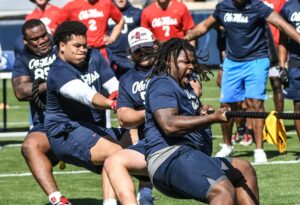Late July and early August give the college football world a glimpse into the season at hand. Conference media days and the beginning of Fall Camp signify the end of summer and the start of the season. However, the last 72 hours have put the nation on the precipice of the biggest change in the sport in over 30 years. What started as a rumor on Wednesday has turned into what seems to be a certainty with Oklahoma and Texas on the verge of joining the SEC. We’ll look at what this means for the SEC, Big 12, and the country as a whole as two rivals stick together to create a seismic change in college football.
What set this into motion?
Oklahoma and Texas, foundational members of the Big 12, have shocked the country with their desire to leave the conference. However, there was not a single event that led to this movement. But, a series of events over the last decade led to the position for the Sooners and the Longhorns. Money and television contracts are the prime motivators here as you would expect. Although, perception of a league that was not on the same level as others certainly didn’t help the situation.
In 2012, the Big 12 put itself in a position to be a major player in the conference hierarchy with a 13-year, $2.6 billion contract with FOX and ESPN. At the time, it was set to pay each member $20 million each. However, recently other leagues began reaching deals that far surpassed the Big 12’s deal. In December, ESPN announced a huge 10-year, $3 billion contract. Coincidentally, it seems that was when the talks between Oklahoma, Texas, and the SEC began.
For Oklahoma, the relationship with them and the Big 12 and FOX has been on rocky grounds over the last couple of years. The Sooners have been generally displeased with receiving more than their fair share of 11:00 AM local kickoffs. And perhaps the item that brought this to a point of no return was in May when Oklahoma’s game against Nebraska was set to yet another 11:00 AM kickoff. Sooners Athletic Director Joe Castiglione attempted to work with FOX for an evening kickoff to no avail. Castiglione took to social media to voice his displeasure. Big 12 commissioner Bob Bowlsby didn’t exactly have the Sooners back at conference media days “We all signed the TV contract,” Bowlsby said.
Oklahoma and Texas inevitable to the SEC
At this point, it doesn’t look like there is much that would derail this move. Multiple outlets have reported that Oklahoma and Texas intend to provide written documentation of their desire to leave the Big 12 conference within the next 24-48 hours. Additionally, it’s also been reported that the SEC would likely vote within the next two weeks to officially invite Oklahoma and Texas into the SEC. Even though there has been public opposition from Texas A&M, it’s likely that no other member of the current 14-team league would oppose such a vote. Interestingly enough, a seismic change in college football such as this may materialize quite quickly.
However, how quickly could Oklahoma and Texas participate in the SEC should an invitation be extended? First, it’s important to note that the existing Big 12 Grant of Rights extends into the 2024-2025 season. But, the likelihood of Oklahoma and Texas participating as members of a conference they are trying to get away from for four more seasons is remote. If they leave before the contract ends, there is likely a penalty to the tune of approximately $68-$70 million each. The desire for this break-up to happen quickly likely comes to the forefront. All parties involved would anticipate Oklahoma and Texas very likely as SEC members in the 2022 season.
What will the SEC look like with Oklahoma and Texas?
One of the most interesting parts of this discussion will be how the SEC integrates Oklahoma and Texas into the conference. Division alignment, schedule format, and cross-over games will all have to be decided. Will the SEC keep Oklahoma and Texas together in the same division or look to integrate them separately? Are we going to see two eight-team divisions or more of a pod format? Conventional wisdom would point to a two-division league that looks something like this:
SEC West
- Oklahoma
- Texas
- Texas A&M
- Arkansas
- LSU
- Missouri
- Mississippi
- Mississippi State
SEC East
- Alabama
- Auburn
- Georgia
- Florida
- Tennessee
- South Carolina
- Kentucky
- Vanderbilt
A nine-game conference schedule looks likely with seven divisional games each year and two cross-over games each year to complete the conference slate. Cross-over games will be intriguing to see how they will be selected in this ever-changing climate of the SEC.
Future of the Big 12 and the Domino effect
Suffice it to say that the Big 12 is in trouble. How much trouble remains to be seen. On the surface, discussions with some combination of Houston, SMU, Central Florida, Cincinnati, and Memphis seem likely to replace Oklahoma and Texas. While this does not allow for the league to stay the same, it does allow for the league to remain viable. Alternatively, the remaining eight members of the Big 12 could question the long-term viability of the league. There are already reports that Big 12 members have reached out to the Big 10 and PAC 12 respectively for interest. But, no matter what, the next few months will be a wild ride and the trajectory of the landscape will be changed in the most seismic change in college football history.
[pickup_prop id=”9060″]






